ACOLON
Vitis vinifera- Blaufraenkisch (lemberger)X Dornfelder
A recent German crossing(1971) authorised in 2002. There are a couple of East Anglian plantings of this new red grape. Thought by some to have potential in England, I am not so sure. Sugars are reasonable as is the colour. Not great in sparkling rose. Appears to be having some success in Belgium. I rest my case.
ALBALONGA
(sylvaner x Riesling ) X ( Rieslaner X Sylvaner) – GP
ALBARINO
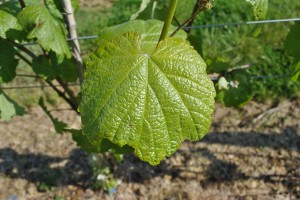
Vitis vinifera – (Savagnin = Traminer) x ?
Usually associated with Galicia in the north of Spain. Its thick skin apparently gives it some protection against the damp conditions. Sugar levels are surprisingly high, though high acidity remains an issue.
English Terroir has made the first Albarino Bacchus (50/50)wine from the 2013 harvest for release in 2015.
ARBANE
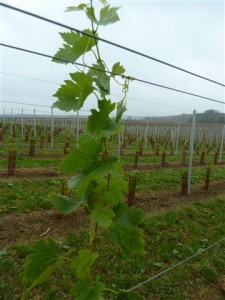
Vitis vinifera
An obscure champagne variety, originating in the Aube region. Now grown in England, a grape that is attractive only to the most masochistic and optimistic grower. Having said that, it does have rather interesting serrated leaves
Budburst is early, the vine is vigorous with a fantastically long vegetative cycle. Harvest dates are very late, yields are very limited. 17th of October and 1.6kg a vine in 2014.
It is susceptible to disease, in particular Mildew. The question you might ask is, why it was ever grown? The answer is its ability to hold its high acidity level even in full ripeness, giving you a nice blending option.
Could not resist, so have persuaded Richard Balfour-Lynn to plant 120 vines at Hush Heath.
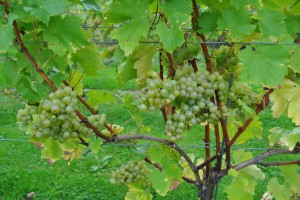
Harvest- 17-30th October
Sugars- 60-69
Acid – 12.5g/l +
AUXERROIS
Auxerrois Blanc , Auxerrois Blanc de Lauenexy.
Vitis vinifera – Heunisch Weiss x Pinot
Thought to have originated in Lorraine and is a cross between Pinot Noir and Govais Blanc ( as is Chardonnay).
Makes reasonable if not very exciting sparkling base wines. Ripens a little earlier than Chardonnay and if I was thinking of planting north of Chelmsford this variety would merit some consideration.
Grown in Sweden(Kopingsberg)
Alsace “Pinot Blanc” wines may consist of Auxerrois Blanc, Pinot Blanc, Pinot Noir and Pinot Gris.
BACCHUS
Vitis vinifera- (Silvaner x Riesling) X Muller- Thurgau
Bacchus133?
High quality aromatic white grape, widely grown in England. A German crossing for the early 70s (Silvaner X Riesling)X Muller-Thurgau. Always being described as England’s Sauvignon Blanc in journalistic shorthand, it is a key grape in the English Wine industry.
In the vineyard, Bacchus is perhaps not the easiest of grapes to grow. It is susceptible to Powdery and Downey Mildew and Botrytis. It has been known to rot Nobly in the right conditions. It is occasionally prone to Coulure (poor flowering), yields of 5t/a are rare but not unheard of. It ripens early to midseason for most winemaking styles, retaining its acidity even in the hottest of years.
Currently being planted on a large scale, mainly led by Chapel Down. New plantings at Nutbourne in 2011 and Kingscote in 2012 and 2013
Harvest- 7-15th October
Acid- 8.5-11g/l
Sugar – 65-80oc
BACO 1
Hybrid completely useless for anything wine-related.
BRANT
Ornamental use only.
CABARET NOIR (PIWI)
Cabernet Sauvignon x ?
Year of Crossing: 1991
CABERNET BLANC (PIWI)
Vitis Vinifera – Cabernet Sauvignon x Regent
Year of Crossing: 1991
CHARDONNAY
Vitis Vinifera – Heunisch Weiss x Pinot Noir
It would appear that Chardonnay derives its name from Cardus – Latin for thistle, thence Cardoon- Chardon in French which named the Burgundy village of Chardonnay Saône et Loire and ultimately the grape. The grape itself is a crossing of a Pinot and the near-extinct Gouais blanc, widespread in NE France in the Middle Ages. Gouais vines were given to Gaul by Probus, 3rd Century Roman Emperor from Dalmatia.
After Pinot Noir now the most planted variety planted in England, ripening a week to ten days after Pinot Noir. Site selection is of crucial importance. Bud-burst is before Pinot Noir and as a result, is more prone to both spring and autumn frosts though strangely seems to set better in poor conditions. Again there is a wide selection of Champagne and Burgundy Clones available, as with Pinot Noir there is some debate as to its suitability for still wine production in the UK, I can promise you that it is.
There are 28 ENTAV clones – clones below are known to plant in the UK
F75(FPS43+46), F76(FPS69) ,F77(FPS44+45) muscat type, F78(FPS39)?, F95(FPS37+38), F96 (FPS70) ,F121(FPS99), F124(FPS84,98), F130(FPS82), F131(FPS100), F277(FPS42,49,51),F548, F809 muscat type
Viticulture
Shares the dubious distinction with Rondo as having the earliest budburst in the UK. In 2011 – April 10th, 2012 – April 2nd, 2013 – April 2nd (then no movement until May) 2014- April 2nd
Harvest dates are usually 7 to 10 days after Pinot Noir.
5th of November at a frost-free site in Sussex in 2010.
2013 -22nd October- 7th November
2015 – 1-7th November
DIVICO (PIWI)
Vitis Vinifera – Gamaret x Bronner
Year of Crossing: 1997
DORNFELDER
Vitis Vinifera – Hefensteiner X Heroldrebe
Another Red crossing from Germany enjoying some popularity in England. Some growers have struggled with its erratic yields, it can overcrop dramatically and struggles in these years to reach a decent sugar level. Colour tends to be on the light side.
The wine is probably best used in a blend adding some much need finesse to varieties such as Rondo.
Harvest – late October
sugar 55-75
FABERREBE
Vinifera – Chardonnay Blanc X Muller Thurgau
Another disappearing variety. Made very nice wine but never got any traction in the UK. Difficult to grow perhaps with indifferent yields?
GUTENBORNER
Vitis Vinifera – Muller- Thurgau X Chasselas Napoleon
Another obscure Geisenheim crossing from the 1930s. Planted at Carr-Taylor (Westfield) and at Tenterden in the late 70s and still grown at the latter, it survived because it actually made a very nice wine, usually as part of a blend. Less disease-prone than M-T, higher sugars and a distinctive spicy taste. Never really caught on and I am not aware of any recent plantings.
The Tenterden plants were grubbed in 2013.
HIMROD
Vitis interspecific crossing – Sultanina x Ontario
Grape variety trailed by R. Barrington Brock. apparently a vigorous grower and prone to miss a year. Seedless. Medium to small berry. ” Not noticeably American in flavour ”
HUXELREBE
Vitis Vinifera- White Elbing x Muscat precoce de Samur
Synonyms Alzey S3962
Interesting aromatic germanic crossing by Georg Scheu in 1927 at Alzey. Named after Fredrick Huxel who was one of the first to propagate it on any scale in the 1950s. (Germany)
Makes an excellent varietal wine but pretty rare, tends to be blended
large bunches, thin-skinned, high sugars possible, retains acid well even when very ripe, susceptible to wasp damage and botrytis, has been known to go Noble.
New plantings at Nutbourne in 2015
An integral part of Nutbourne’s Sussex Reserve blend, the 2013 vintage won the first IWSC Gold for and English Still wine
LEON MILLOT
Vitis interspecific crossing – Millardet et Grasser 101 O.P. x Goldriesling
Another french hybrid trialled by Barrington Brock. Makes a rather green and stemmy wine from my limited experience (1). Dying out by the 70s
MADELEINE ANGEVINE
Early, regular cropper of strangely aromatic grapes. Usually used in blends, the wine is not to everyone’s taste. Quite interesting oaked versions have been made. Introduced in the 70s -80s but not much planted now.
MARSHAL JOFFRE
French hybrid trailed by Barrington Brock – have never tasted wine from this variety
MERLOT
Vitis Vinifera
The surprise is that this is grown in England at all, the other surprise is that the grapes can actually be used for winemaking. You can forget about red wine but it does make a surprisingly good base wine for sparkling (white).
Harvest- late October in a good year
Acid 13-15+
Sugar 60 oc (if you’re lucky)
MULLER-THURGAU
Vitis Vinifera- Riesling X Silvaner?
GDD 1700
Some question mark over the parentage of this vine. Bred by Dr Muller of Geisenheim and Wadenswil in Switzerland in 1882.
I am struggling to think of a vineyard where M-T is still grown on any scale and it properly belongs to a different era. At one time the ‘benchmark vine’ in the UK by which others were judged, this only hastened its decline, poor yields( due to suspect flowering) and susceptibility to the whole range of fungal diseases encouraged by the English climate curtailed its popularity.
When it could be prevailed to bring forth a decent and clean grape the wines could be of good quality across a range of styles, slightly flowery, spicy at its best more often than not flabby and dull.
In 1987 in 146 ha represented approximately 27% of the Uk plantings by 1999 this had gone down to 13 %, though apparently still the most planted by area at this time.
MUSCARIS (PIWI)
Vitis Vinifera – Solaris x Muscat a petits grains blancs
Year of Crossing: 1987
OPTIMA
Vitis Vinifera – (Silvaner X Riesling) x Muller- Thurgau
Early ripening and high sugars. Denbies have had some limited success with a dessert wine made with a little Optima.
ORION
Vinifera (hybrid)
Geilweilerhof crossing of Optima and Seyval Villard 12-375. Still waiting to taste a 100% Orion wine.
ORTEGA
Vitis Vinifera – Muller-Thurgau X Siegerrebe
GDD 1500-1600
First registered in 1971
A grape that really should be more common in England. It ripens early and is capable of high sugar levels while at the same time maintaining good acidity. Its thin skins can allow it to be susceptible to rot, it will rot nobly in the right conditions. Early budburst? may make it sensitive to frost, which begs the Denbies question.
Versatile as regards wine styles, dry, dessert and oak styles are all possible.
Biddenden are the most successful exponents and growers. Mersea had some excellent fruit.
PETIT MESLIER
Vitis vinifera
Crossing of Gouais blanc x Savagnin
Synonyms- Arbonne,Bamay,Bernois, Bernet, Co de France,Crene, FeuilleD’Ozerolle, Henneq.., Lepine,Maille, Maye, Melie, Melie blanc, Melier, Mesilier de champagne, Mesilier Dore, Mesilier Petit a Queue Rouge, Mesilier Vent, Morain blanc, Orbas, Petit Mesilier, Petit Mesilier a Queue Rouge, Petit Mesilier Dore, Queue Rouge, Saint lye.
Originating in northern France, this is one of the 6 (or 7?)varietals allowed in Champagne but you will struggle to find it. In 2006 there appeared to be less than 1 ha in the whole of France. It has been planted in the UK. In 2003 around 10 clones were in the champagne collections.
Budburst appears to be early and it is susceptible to spring frosts.
Harvest is late, after Chardonnay.
In addition to its precocity, it is also prone to millerandage and coulure so it needs a really good, exposed site with long canes and lots of buds. It is also very sensitive to Botrytis.
The bunches and grapes are small, with low yields. It makes a lively, aromatic base for sparkling wine. I have tasted it as part of a blend and can vouch that it is interesting.
I believe that some has been planted in England. Hope to add it to the Hush Heath assemblage in 2012.
First harvest at Hush Heath 17/10/14 BW. 101 SG 67 TA 12 ( chardonnay picked on the same day ranged from BW 190-200g SG 76 TA 10). It now forms part of Les Sixes Blend of sparkling wine at Hush Heath to be released in 2016.
PHOENIX
vinifera(complex hybrid) Bacchus X Seyve Villard 12-375
Greeted with some excitement a few years ago this variety has proved to reflect its parentage producing a dull sub-Bacchus like wine.
Sugars can be low and acid high, strange oversized grapes.
Plant Bacchus.
PINOT BLANC
Pinot Blanc is a white mutation of Pinot Noir. Not as fashionable as Pinot Noir and Chardonnay in English eyes, Pinot Blanc deserves better and is an ideal grape for England. For many years it was the white part of Chapel Down Pinot Reserve, strangely Chardonnay did not appear there until 2006.
I planted it extensively while at Chapel Down. Roundbush in Essex, Tenterden, Lamberhurst, Sandhurst and Budds (Rolvenden).
In Champagne, it is known as “Blanc Vrai” and makes up one of the six or seven permitted varietals.
has the potential to overcrop, high bunch weights, green harvesting advisable
Stopham Vineyard makes an excellent still Pinot Blanc as do Chapel Down (usually).
PINOT GRIS
Becoming increasingly fashionable to plant in England as well as strangely in the rest of the world. Lovely examples from Alsace and Northern Italy; bland, boring and disappointing from nearly everywhere else. In England sugars between 75-90 oc (10-12.4%) are not unknown, the acidity seems to remain resolutely high, between 12-13 g/l at harvest. Good examples are to be found, most notably by Simon Woodhead at Stopham in Sussex.
Apparently grown in Champagne in the 18th century where it was known as “Fromenteau”, very obscure.
Has been used as a sparkling base in England
PINOTIN (PIWI)
Vitis Vinifera – Cabernet Sauvignon x Regent
Year of Crossing: 1991
PINOT MEUNIER
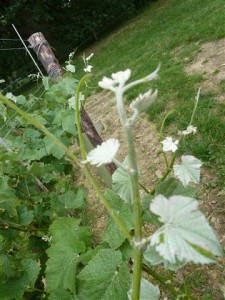
Vitis vinifera
The last of the Holy Trinity of the champagne grapes is woefully underrepresented in current UK plantings. Mentioned with seeming embarrassment in Champagne,(unless your name is Krug) it actually occupies 40% of the planted area and is the workhorse and occasional star of the industry. Less fussy as to site it is more frost-resistant than either Pinot Noir or Chardonnay. Yields tend to be slightly lower than Pinot Noir, it usually ripens a few days later but is rather more reliable?
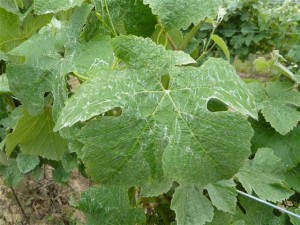
Millers Burgundy seems to have a had a long history in English wine,
it is certainly mentioned by Switzer in 1717 in a list of grapes brought over by Lord Capel and Sir William Temple (Chasslas,Parsley?Frontignac, Amboyna, Burgundy, Black Muscat and Grisly Frontignac}
Hervey 1802 lists 267 varieties , no 18 is Millers Burgundy, Millers Cluster, Meunier Grape or Millers Grape “this variety was originated from seed by Miller about 1720. it is a hardy grape and was used for making wine at Painshill vineyard in 1750 . The berries are middle sized and pleasant.”
Scotts Orchardist 1820
Millers burgundy is listed as berries round or nearly so
Miller grape, Meunier, Bluer Mullerebbe
“Bunches short, cylindricaland compact with a long stalk;berries small round inclining to oval, uniform in size, with short warted stalks ;skin thin, black, and covered with blue bloom; flesh red sweet, juicy and lightly flavoured, and contains two seeds . an excellent grape for outdoor cultivation as it ripens well against a wall. It is easily distinguished from other Grapes by its very downy leaves which when they are first extended are almost white, and this in some degree maintain during the greater part of the season, On this account it sis called the Miller .
Still white wines have been made successfully over the last few years , Kingscote, Litmus, Simpsons and others have made interesting examples.
In 2018 I made a Red Meunier at Hush Heath from a Kent site , It was released as”The Red Miller” and garnered a fair amount praise and the first IWC Gold medal for an English Red.
PINOT NOIR
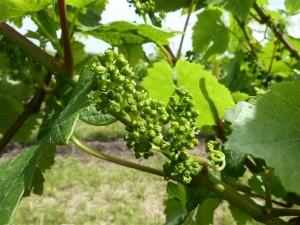
Synonyms- Pineau de Bourgoyne, Franc Pineau, Noirien, Franc Noirien, Salvagnin, Morillon, Auvernat, Auvernat Noir, Plait Dore, Vert Dore
Historically in England it is identified as Small Black cluster, Auvernat or Black Burgundy (Hervey 1802)-” an old variety from Burgundy with hoary leaves, It is a good wall fruit. the berries are small and pleasant.”
A cool climate grape from Burgundy and Champagne. Now the most planted variety in England, but beware it comes in many guises, there are over 400 clones of Pinot Noir. They vary hugely in yield and character, clonal selection and rootstock are vital. Champagne clones are capable of yields up to 6 tons/acre, Burgundy clones with smaller bunches and generally higher sugars can crop around 3 tons/acre.
The earliest of the classic varietals to flower in England. In 2012 the first flowers seen at Hush Heath were on the 28/6/12
Coulure can be a problem in cool wet years (2012) with a severe impact on yields.
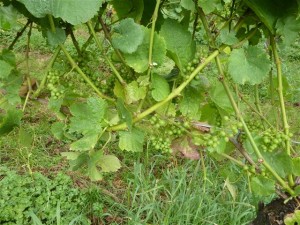
Tete de Negre is one of the more unusual Pinot clones, as far as I know, it is the only teintuier Pinot Noir (or is it Meunier?), apparently from Burgundy and banned. Young shoots show redder and the leaves darker red leaves.
Clones
PN 113, PN 114, PN115, PN 777, PN 667, PN 828
PN292,PN375, Pn459, PN 386, Pn521
Viticulture
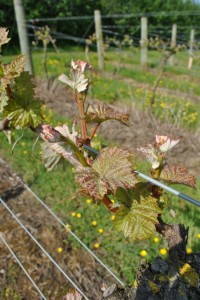
Susceptible to Coulure, low temperatures before flowering?
Budburst is typically 5-7 days after Chardonnay, usually mid-April
Flowering – end of June
Harvest – mid-October
2011- 29th September
2013 – 22nd October
2015- 23rd October
TA 10-14g/l
Sugar 65-85 Oc
PINOT NOIR PRECOCE (early pinot noir)
There used to be rather more of this variety planted than vineyard owners let on, after all, who wants to label their wine Fruhburgunder. This is an early ripening clone that is almost certainly related to Pinot Noir. It yields moderately well with high must weights and low acids, often harvested 2-3 weeks before traditional Pinot Noir, interestingly final bottled analysis of red wines made from this grape are almost identical to wine made from Pinot Noir. Apparently also grown in champagne(presumably labelled Pinot Noir) and allegedly used for starting early malo-lactic cultures.
This is allowed in the English Sparkling Wine PDO labelled as Pinot Noir.
REGENT
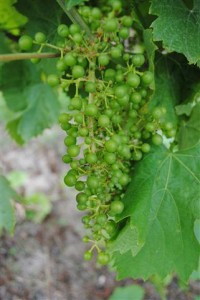
A relatively new red German Hybrid. The quality of the wine is surprising considering its mixed parentage. (Silvaner X Muller Thurgau) X Chambourcin since you ask. Can make a more refined wine than Rondo, it will take oak and in winemaking, terms is relatively straight forward with reasonable colour and manageable acidity. It sometimes shows some reluctance to being destemmed.
In the vineyard, again Regent presents no major problems. Fruit set isn’t always what it could be as can be seen in the photo. It is supposed to have some fungal resistance, it appears to be more resistant than Rondo to botrytis and has been harvested 2-3 weeks after Rondo.
2012 was another difficult year across most varieties, the below photo shows Regent at the end of August 2012, note the almost autumn colouring on the leaves and millerandage.
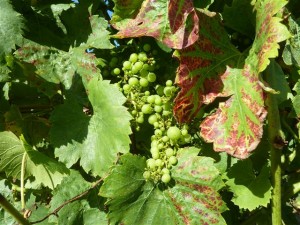
REICHENSTEINER
Vitis vinifera – Muller-Thurgau X (Madeleine Angevine x Calabreser-Froelich)
Once very popular in the UK. Reliable and high yielding variety, with high sugars and reasonable acid levels. Somewhat neutral in flavour it works well as a sparkling base, particularly as part of a blend. Plantings are dwindling but interest is being revived as growers and wineries assess the harvests of the last few years (2010-15)
New plantings in Kent, Essex and Sussex in the last couple of years – nursery stock has been difficult to source.
RIESLING
Vitis vinifera
At the very edge of English cool-climate potential comes Riesling, a lot of people talk about planting it. Denbies experimented with it but I think only produced 1 vintage (95? a hot and frost(small yield) affected year) which was pretty good. Rathfinny have planted a selection of German clones(2012?)
RONDO
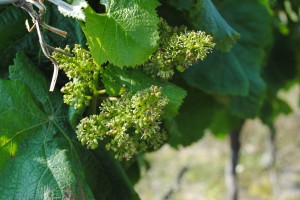
Rondo is a red grape that promises everything but invariably disappoints as red wine. Early ripening (I seem to remember some being harvested as early as the 20th of September – 8th September in 2011), yields of up to 11 tons/acre. High sugars and great colour. Susceptible to spring frost as budburst is early and also to coulure.
The first of the varietals to flower. 2012 – 24/6/12 with 50% by 29/6.
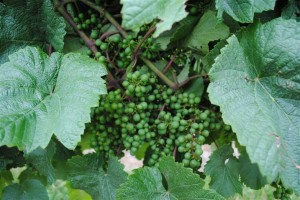
Excellent for rose, requires no maceration (tastes better without it)
RUSSIAN GAGARIN
Russian crossing trialled at Oxted. berries small and sweet non-muscat flavour
RUSSIAN TERESHKOVA
Trialled at Oxted. Small, black berries
SAUVIGNAC (PIWI)
(Sauvignon x Riesling) x ?
SIEGERREBE
Vitis Vinifera- freely pollinated seedling of Madeline Angevine apparently.
This grape should be more widely planted in England than it is, it has the shortest growing cycle of any varietal (88 days?) and can achieve exceptionally high sugars 90-100 oc. Here in maybe lies the problem. The grapes are usually ready 2 weeks before anything else(even rondo), harvest preparations will barely have begun in some wineries, last-minute bottling to empty tanks, harvest team still flying in etc. This is a shame because it is an excellent and versatile grape. If I was up north this is what I would grow instead of the raw potato flavoured Seyval. Picked early while it still has some acid and has turned full pink it makes a beautiful aromatic wine with a muscat Bacchus like character , left on the vine it can become very attractive to wasps as it turns to a dark browny pink, the acids tend to drop quite quickly at this stage and single varietals can be a bit flabby and blowsey but fantastically useful as a blending option .
Three Choirs have quite a lot. I planted an acre at Tenterden and have encouraged a new planting at Kingscote (2012).
SCHONBURGER
Vitis vinifera
A grape variety that had some popularity in the 1980s and suffered somewhat in the change of fashion away from the germanic wine styles. Burdened with a cumbersome name and a tendency to drop acid like T. Leary if left to hang too long. Having said that it would always hang clean and was capable of high must weights but with a tendency to flabby sub gwertstramier style. Picked early with decent acid has a bacchus/rose petal character. Usually ends up in a blend, its pink grapes work very well in aromatic roses.
Chapel Down’s English Rose, Nutbourne Blush usually have it as part of the blend.
SEYVAL BLANC
syn. Seyve Villard 5/276 Hybrid
A most hideous and boring grape.
Unfortunately undergoing a mini-revival by those seduced by its occasional tendency to overcrop and provide bulk filler for sparkling wines.
The skins will block up your press and the juice will usually taste like an old potato and cabbage in your finished wine. That being said there are fans of the rustic style.
Can be problematic to source. This difficulty has not been sufficient to discourage planting.
SOLARIS (PIWI)
Vitis vinifera – Merzling x Geisenheim 6493
Year of Crossing: 1975
SOUVIGNIER GRIS (PIWI)
Vitis Vinifera – Seyval x Zaeringer
Year of Crossing: 1983
WROTHAM PINOT
Wrotham Pinot is something of a mystery in the recent (living ) history of English Wine. The vine was found at a cottage in Wrotham by Edward Hyams who took cuttings which were propagated by Barrington Brock at Oxted(Dr S.P.Skelton- The Wines of Britain and Ireland, has a good section on the revival of English grape growing). It resembled Pinot Meurnier but apparently ripened 2 weeks earlier than French Pinot Meurier and with higher sugars! It could be that there are examples still being grown somewhere in the UK but I am not aware of any. Gillian Pearkes has it growing in Essex with good sugar readings in the 70s, not sure where.
WUZER
Vinifera- Gewusrtraminer X Muller-Thurgau.
synonyms – Wuerzer, Wartberger
Really now only of limited interest and rarely found in the UK. High in acid and late-ripening, it can be interesting in a blend adding a Bacchus like character. Its heavy tight bunches and yield coupled with its late ripening make it prone to Botrytis and other fungal diseases, its viability is dubious, to say the least. Plant bacchus.
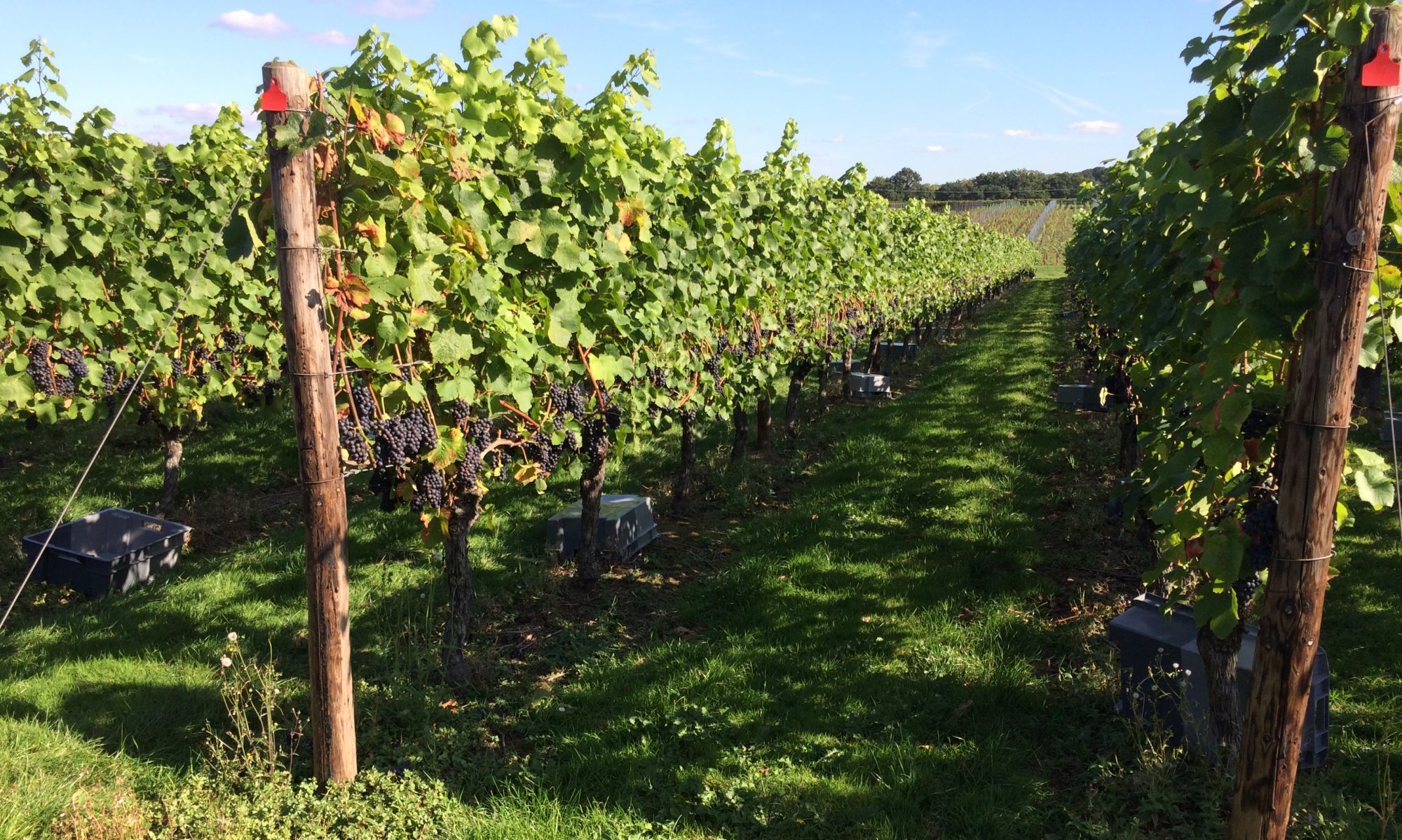
Could you include a bit about Muller Thurgau. I know it’s become a bit unfashionable but it is still grown here.
Hi – I am looking for guidance on growing conditions for pinot blanc . I am currently planting 7 acres of pinot noir near Modbury in sw england and am looking for a good white variety for 4 acres.
best wishes
Hi
I rather enjoy your blog – do keep it up! I have a question if i may:
How do you think Pinot Blanc and Pinot Meunièr would do on a site in the north of England (Derbyshire)?
We have a sheltered SE facing slope with a tilt to the south to plant next year. Next door (opposite side of the valley) we have a vineyard we planted last year with Seyval, Solaris, Phoenix, Rondo and Pinot Noir preccoce (the latter two in small quantities).
Both sites are really well sheltered sunny sites with decent slopes of around 15-30 degrees to make the most of the sun. There are even large(ish) bodies of water below, old reservoirs that might just provide some limited benefit regarding spring frosts. The only downside is the sites are a little high at around 190m to a max of 220mASL.
Regards
Barry
Dear Barry, I would be nervous about recommending those varieties at that height and so far north// Owen
Dear Owen,
I love your blog. I’m doing a project with Pinot noir clones and read that you said that now is the most planted variety in the UK, please could you tell me where have you found this information as I’ve looking for the last figures of Pinot noir planted in the UK and the latest that I found where from 2009.
Thank you very much.
Kind regards,
Inma.
I am a member of Ventnor Rotary Club on the Isle of Wight.we twin with Rouen in France. We are contributing 500 vines to a project which will employ young people in the wine industry.
The land is on the outskirts of Roen in Normandy on a south facing slope
I have read your descriptions and comments and wonder if you can advice please ?
I have narrowed down to Bacchus,Pinot Blanc,Pinot Noir Pinot Meunnier,Reichensteiner and Siegerrebe
Can you advise which might be best where to buy good healthy plants and how much they are likely to cost ?
Many thanks, JohnWhitehouse
Hi Owen,
Very decent blog.
I was interested that you comment Huxelrebe makes an excellent wine. Most peeps say that the wine is unsubtle, but I once tasted a tries (three sweeps) harvested selection that was dry, not remotely muscatty and closer to a white wine from Languedoc/Rousillon.
Is it that the grape is by nature very variable due to ripeness, year, yield and terroir?
Tim.
Wrotham pinot: I planted one (ungrafted) in my garden in West London 8 years ago and it now extends several metres along a simple pergola, protected by netting when ripening. It has never produced a decent red wine, mainly due to high acidity. Even now (19/10/15) the pH is 3.0, although the sugar level is quite good at 18 brix. However, I have made wine from the pomace, which underwent a malolactic fermentation in the bottle and produced a very pleasant sparkling wine.
I have found this blog most useful and would like to add comments on varieties not listed, if I may.
Madeleine angevine is the classic variety for the UK, inasmuch as it will produce fruit in cool regions, being the earliest ripener. I planted 2 and they established quickly. The sugar levels and flavour are unimpressive, but the disease resistance is good and I have bought 3 more as an insurance policy against poor seasons to come.
Golden chasselas is worthy of mention as an early variety. I also planted 2 of these. 1 has died after a modest crop and the other looks sick. I won’t be planting any more.
Vroge van der Laan: I picked up 3 of these from my local florist. Although a white variety, one produced black grapes, so wrongly labelled! The other two have yet to produce enough grapes to make a judgement, other than they do not ripen in August, as claimed!
Dunkelfelder is a red-fleshed variety, valued for its colour and little else. I inherited 3 of these, from an original planting of 32, since when one has died. They are prone to powdery mildew. I thought I was the only UK grower, but an English dessert wine containing some has recently been accepted for sale at Waitrose.
Frankenthaler is better known as Black Hamburg, the Hampton Court vine. It is a very late-ripening table grape, best suited for greenhouses. I have some, grown from cuttings. The grapes are very large and turning black but still have a long way to go.
Cabernet sauvignon was out of the question 50 years ago, but I have several which are already reasonably ripe already. I have picked them as late as early December and produced excellent wine after a few months in the barrel.
Intrigued, since your list is dated 2010. My sparkling Seyval Blanc 2010 won a Gold Medal in the IWC and is listed in Sketch Restaurant Mayfair, and sells like hot-cakes. It was Chosen by Government Hospitality, Lancaster House last year etc.etc.
Best,Peter xx
I have just bought a south facing slightly sloping south field in Norfolk and want to plant about an acre and half of vines , I haven’t tested the soil yet it has about 100/150mm topsoil on clay with chalk in it , I would like a bullet proof vine to make a red vine not too heavy I think that I am blow 30.m . Above sea level I am aiming to plant spring 2020 what do you think
Simon
Seyval Blanc is used in some Virginia Vineyards (major crops Chardonnay and Cabernet Sauvignon ) and at around 1200 ft. It is used in the frost prone dips where other uses might be wire grown white peaches. The Chardonnay and Cabernet Sauvignon of this region are high quality. Stainless Steel fermentation and French Oak ageing are are common. The variety is used for its ability to flower again after frosts. The reason I report this is that the 100% Seyval Blanc wine produced in Virginia USA is of a pleasant delicate texture with pleasant floral notes. Much wine in Virginia is sold at the vineyard/winery. The Seyval Blanc is sold at a lower price point to the major wines and is highly appreciated by visitors who take it home by the case(s) Personally I have never experienced potato or cabbage as you blog. At the vineyards I am told the original vines are sourced from France where the Grape Variety is otherwise banned.
I lived and worked in Washington DC and frequently visited the mountains I returned to London in my retirement
Thank you for this blog